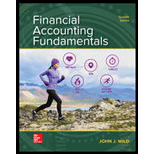
Concept explainers
It means record of financial data related to business transactions in a journal in a manner so that debit equals credit. It provides an audit trail to the auditor and a means to analyze the effects of transactions to an organization’s financial health.
Rules of Journal Entry:
The rules for journal entry are defined by 5 accounting components,
- Assets: Increase in asset should be debit and decrease should be credit.
- Liabilities: Increase in liabilities should be credit and decrease should be debit.
- Equity: Increase in Equity should be credit and decrease should be debit.
- Expense: Increase in expense should be debit and decrease should be credit.
- Revenue: Increase in revenue should be credit and decrease should be debit.
Credit Card:
It refers to the card made of plastic and issued by a bank. It provides an individual to buy goods and services on credit when they have shortage of cash.
Perpetual Inventory System:
It refers to the system of recording transaction related to inventories at the time of their occurrence. Each sale and purchase is recorded at the time they occurred.
To prepare: Journal entries for the given store credit card sales transactions.
Want to see the full answer?
Check out a sample textbook solution
Chapter 7 Solutions
FINANCIAL ACCT.FUND.(LOOSELEAF)
- What is the ending inventory?arrow_forwardExercise 10-8 (Algo) Prepare the stockholders' equity section (LO10-7) The Golden Mushroom has two classes of stock authorized 8%, $10 par preferred, and $1 par value common. The following transactions affect stockholders' equity during 2024, its first year of operations January 2 February 6 Issues 100,000 shares of common stock for $28 per share. Issues 2,300 shares of a preferred stock for $12 per share. September 10 Purchases 10,000 shares of its own common stock for $33 per share. December 15 Resells 5,000 shares of treasury stock at $38 per share. In its first year of operations. The Golden Mushroom has net income of $153,000 and pays dividends at the end of the year of $95,000 ($1 per share) on all common shares outstanding and $1,840 on all preferred shares outstanding Required: Prepare the stockholders' equity section of the balance sheet for The Golden Mushroom as of December 31, 2024. (Amounts to be deducted should be indicated by a minus sign) THE GOLDEN MUSHROOM Balance…arrow_forwardI need help with this general accounting problem using proper accounting guidelines.arrow_forward
- Principles of Accounting Volume 1AccountingISBN:9781947172685Author:OpenStaxPublisher:OpenStax College
 College Accounting, Chapters 1-27AccountingISBN:9781337794756Author:HEINTZ, James A.Publisher:Cengage Learning,
College Accounting, Chapters 1-27AccountingISBN:9781337794756Author:HEINTZ, James A.Publisher:Cengage Learning, Financial Accounting: The Impact on Decision Make...AccountingISBN:9781305654174Author:Gary A. Porter, Curtis L. NortonPublisher:Cengage Learning
Financial Accounting: The Impact on Decision Make...AccountingISBN:9781305654174Author:Gary A. Porter, Curtis L. NortonPublisher:Cengage Learning  Intermediate Accounting: Reporting And AnalysisAccountingISBN:9781337788281Author:James M. Wahlen, Jefferson P. Jones, Donald PagachPublisher:Cengage Learning
Intermediate Accounting: Reporting And AnalysisAccountingISBN:9781337788281Author:James M. Wahlen, Jefferson P. Jones, Donald PagachPublisher:Cengage Learning



